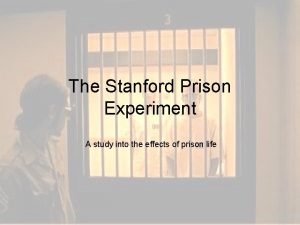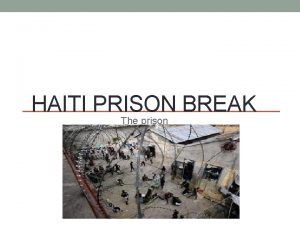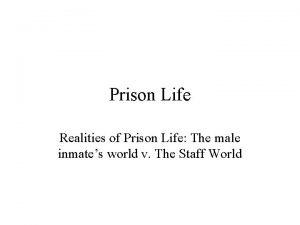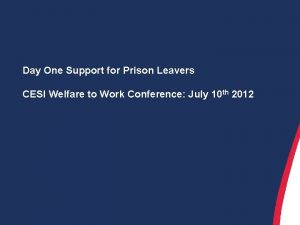Experiences of male prison leavers with multiple needs









- Slides: 9

Experiences of male prison leavers with multiple needs By Sarah Joseph University of Leeds, BA Sociology Student

Background Leeds City Council Urban Impact Project An element of the project was to work with people who receive frequent custodial sentences or who have problems resettling into the community on release from prison. Our aim was to help individuals who are not engaging effectively with services establish a sustainable life in the community. The individuals also are experiencing needs in the HARM areas: - Homelessness Addiction to drugs and/or alcohol Reoffending Mental Health

Research Objectives Topic: What are the barriers and difficulties, and what could be the positive pathways for prison leavers with multiple needs in having fulfilled life in the community upon release? This includes gaps in the current procedures around: - Issues or concerns in accessing accommodation - The possibility of prisoners continuing drug and alcohol treatment or abstinence that they develop in prison upon release. - Accessing appropriate mental health services. Main question…… Is there an adequate supply of services in Leeds for prison leavers with multiple needs?

Research Methods Semi-Structures Interviews 15 Interviews done inside Prison 7 Interviews in the community Demographic information, opinions on services, ideas on how the services can improve, barriers to accessing services

Results Age Ethnicity HARM Previously Offended Time spent in CJS In Prison 26 - 62 14 WB, 1 BME 11(3, 4) 4(1, 2) 87%, 2 out of 15 on first offence 10 months – 35 years In the Community 29 - 40 6 WB, 1 BME 6(3, 4) 1(2) 57%, 3 out of 7 on first offence Few months – 30 years

Results - Number of men accessing services Service Community (out of 7) Prison (out of 15) Legal Advice 57. 14% 73. 33% Mental health 71. 43% 73. 33% Homelessness 71. 43% 46. 67% Alcohol/drug 85. 71% 66. 67% General health e. g GP 71. 43% 66. 67% Job centre 85. 71% 40. 00% Outreach and Resettlement 28. 57% 46. 67% WYCPP 42. 86% 26. 67% Probation 71. 43% 86. 67% Prison Listeners 14. 29% 33. 33% Family Friends 42. 86% 73. 33% BME specific Male Specific 20. 00% WY-FI Prison leaver workers 66. 67% WY-FI BME specialist WY-FI navigator / peer mentor 6. 67% 42. 86% 46. 67%

Reasons for not accessing services Prison Yes Community No Yes No Lack of understanding 73% 27% 57% 43% Negative staff attitude 47% 53% 86% 14% Not meeting my needs 67% 33% 71% 14% Not delivering what they promised 67% 33% 71% 14% Not having the skills to help 53% 33% 71% 14% Putting barriers to me accessing services 27% 73% 57% 14% Couldn’t see me soon enough 53% 47% 57% 0%

Reviews of all services In the community In prison 13; 14% 15; 28% 44; 48% 26; 48% 35; 38% 13; 24% Positive Average Negative

Recommendations Intensive 1 -1 support within prison and outside in the community A smoother running for mental health services, medication prescribed and counseling given quickly for those in need (inside prison and in community) More clarity given by legal services For all services, improved communication and a more frequent communication. Even if its just to check up on people. More courses to help with general life skills (e. g. budgeting) Maintaining a clear and efficient communication system between agencies in custody and community to enable individuals to engage better with services following release.
 Simple claustral complex
Simple claustral complex Strategic gender needs and practical gender needs
Strategic gender needs and practical gender needs Primary needs and secondary needs
Primary needs and secondary needs Learning needs definition
Learning needs definition Satisfaction
Satisfaction Multiple baseline vs multiple probe design
Multiple baseline vs multiple probe design Multiple instruction single data
Multiple instruction single data Poem about year 6
Poem about year 6 Stanford prison experiment research design
Stanford prison experiment research design Prison ministry training manual download
Prison ministry training manual download

















